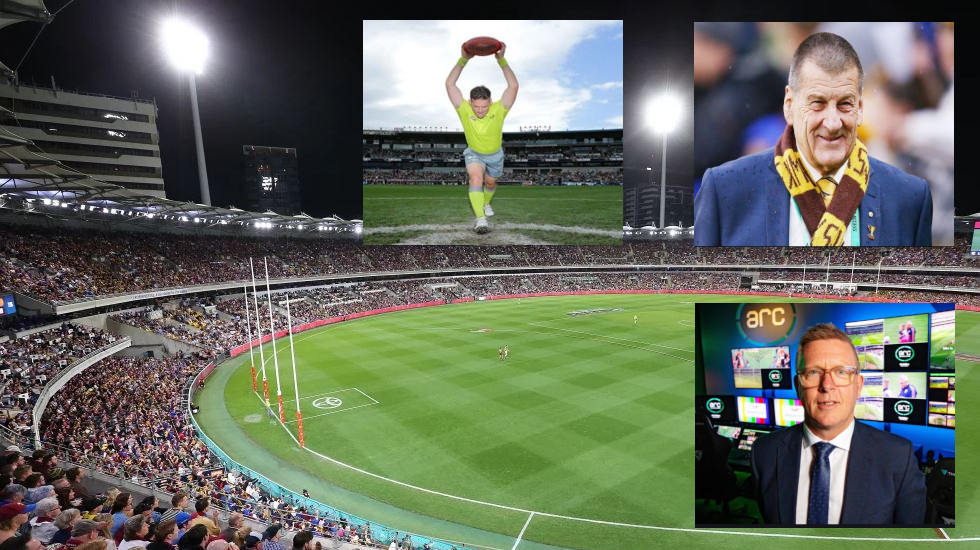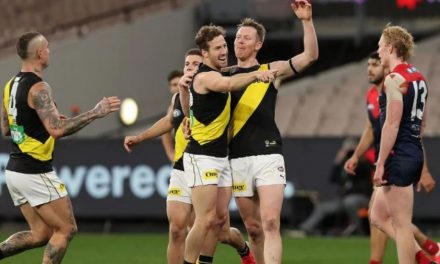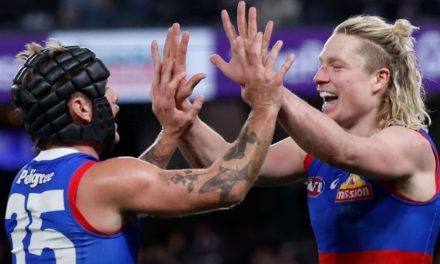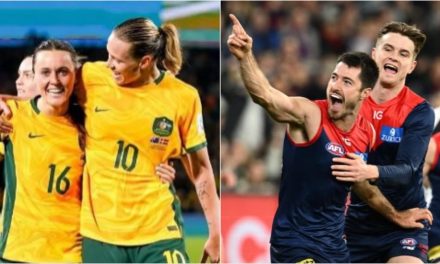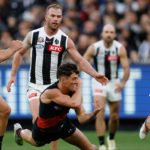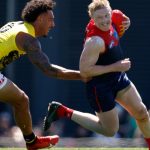The Gabba, new grand final venue. (Inset): The centre bounce, Hawthorn president Jeff Kennett and Steve Hocking at the ARC.
Australian football has made an art of consuming itself with passionate – but ultimately meaningless – arguments that come down to who can shout the loudest.
Many hoped for something different during the COVID pandemic. But while the 2020 AFL season was taken to “unprecedented” territory logistically, there were still enough moments which kept the “old normal” very much in vogue.
Dragged along the way to this new landscape were many well-roasted chestnuts such as the holding-the-ball rule, the score review and the size of the national competition. Let’s have a look at the debate sheets.
ONE FOR ALL, ALL FOR ONE
Hawthorn president Jeff Kennett this year turned from watchdog to attack dog very quickly (and not just in football, as noted with his social media statements on the Victorian State government’s handling of the COVID pandemic).
Kennett’s radio interview with SEN morning host Gerard Whateley in late March – when the AFL went into lockdown – optimistically signalled how 18 national league clubs accustomed to brutal “take no prisoners” combat on the field were united in saving the game amid projections of epic financial pain.
And Kennett warned Whateley he would not tolerate the media – particularly those in the search of click-bait headlines or ratings points – setting up divisions by playing one club’s interests against those of others.
“We are all in this together,” Kennett said. “The last thing we want is having one club, one president disagree with another … I want all clubs kicking in the same direction, all the time. There is no advantage in trying to kick in the opposite direction … we all have to stand together on this.
“How do we come out of this? Together, we will get through it. If we break the chain, that is when you put at risk the outcome. And I will not be part of anything that is not the accepted view of the AFL, the commission and the clubs.”
And in June, when the AFL found its way to return to play, Kennett went rogue. He changed the agenda by putting forward the concept of relegation from the AFL in a letter to his club’s members. So much for unity in troubled times.
Season 2020 promised a “new normal” with more considered debate on how to save the game. But as soon as footballs were being kicked in anger again, the verbal brawling and point-scoring was as vicious as ever. Jeff certainly lost none of his bluster (after staying in practice during the AFL lockdown with his political jousting on Twitter).
If sanity could not be found during deep reflection amid a pandemic, there is indeed no hope for an end to those all-consuming rant sessions that achieve no meaningful change to Australian football. It simply will go on and on and on.
But some topics have reached their use-by dates, surely.
RELEGATION … THE REAL PAIN
Kennett wrote to his Hawthorn members in June advocating a relegation system for the fixed 18-team national AFL competition.
He wanted to set key performance indicators that the AFL Commission would use to determine if a club should retain its place in the national competition.
“The timeline for these key performance indicators should be three years with an evaluation taking place in the third year of performance,” Kennett wrote.
“If clubs and their boards do not meet the KPIs set, they should be relegated to the VFL. No longer can non-performance be supported. This is not directed at any club and is only prospective. Emotion alone is not sufficient a reason for non-performance.
“The AFL must take a more commercial view to the conduct of our code.”
The argument for reform is usually led by non-Victorians arguing there are too many teams (10) in Victoria. Did we learn nothing in 1996 from the demise of Fitzroy, one of the founding clubs of the VFL competition in 1897?
Port Adelaide’s inaugural AFL president Greg Boulton, who on leaving office soon saw his club’s existence threatened by financial pain, wisely notes: “The fans follow a club – not the game.”
Did Fitzroy supporters who declined to embrace the “merger” with Brisbane suddenly take to barracking for other Melbourne-based teams they had jeered and passionately disliked for years and years? Even through generations of their family trees? Marriage allows for divorce to find a new love; football loyalty does not.
Get rid of clubs and you lose fans. And the game – and league – is not better with fewer fans. Sydney president Andrew Pridham’s push for a review of the 18-team national competition should keep this in mind. Sometimes the cost of killing a club can be greater than the cost of carrying the weaker links in football’s chain.
Hawthorn finished 15th – in the bottom four of 18 – this season. Where did Jeff want the cut-off?
While on Kennett’s ramblings, has anyone else noticed that since Kennett has decided to seek an extended term as Hawthorn president – his second coming – he has been very silent on governance and term limits on the seats at the AFL Commission?
GOLD COAST v TASMANIA
Gold Coast has been known as the “Bermuda Triangle” of Australian sport with a long list of wrecks for national league teams.
Australian football’s refuge in Queensland during the pandemic-forced exit from Victoria has offered Gold Coast leaders, in particular Suns chairman Tony Cochrane and chief executive Mark Evans, a welcome reprieve.
They also have more ammunition to ward off the cynics, critics and card-carrying advocates for the AFL to invest in the traditional ground of Tasmania rather than along the fast-growing population corridor between Sydney and Brisbane.
The AFL Commission – much like the International Olympic Committee in awarding the Games to a city – wants a legacy to remain from the AFL grand final being played in Brisbane this weekend.
The impressive figures on grassroots growth in participation with both male and female players – in rugby territory – highlight the need for a meaningful legacy in Queensland.
And if the Suns – the only AFL team to not have a top-eight finish on their record – do rise, every hit on the Gold Coast expansion franchise (that has included jabs from Leigh Matthews in 2016) will still draw that trusty “one wood” from Cochrane: “Everyone is entitled to an opinion – and that is all that it is, an opinion. Opinions are like arseholes, everyone’s got one.”
Tasmania? Everyone – in particular Tim Lane, Robert Shaw and Matthew Richardson – would enjoy the green jumper with the yellow map of Tasmania to appear in the AFL wardrobe. But can the AFL afford expansion – and a return to the dreaded bye – with a 19-team national competition?
Yes, it does cost less to finance an AFL team now – but there also is less money to underwrite small-market clubs.
Get rid of Gold Coast? Not going to happen now. Not even North Melbourne gets to revisit that (lucrative two-homes) deal that then AFL chief executive Andrew Demetriou put on the table a decade ago.
THE BOUNCE … THE BLOODY BOUNCE
Be honest. When was the last time … actually did you ever buy a ticket to an AFL match because your “game-day experience” was fulfilled by watching an umpire bounce the ball in the centre circle at the start of a quarter or on the 6-6-6 reset after a goal?
Who won “Bounce of the Year” in 2015?
Field umpire Ray Chamberlain’s struggle with the bounce – that should never be more relevant than his ability to call correct decisions – has reignited the bounce v throw-up debate.
Tradition would dictate the ball be kicked from the centre circle to start and restart the game and after goals are scored. But no-one is arguing for the game to return to its foundation roots (1858-1886).
Richmond premiership hero – and a traditionalist at the Laws of the Game committee – Kevin Bartlett took to Twitter during the Chamberlain moments to say: “In Australian football, the centre bounce should be retained and not be replaced with a tip off. The game never had a recall rule for 112 years in the VFL-AFL. The umpire bounces the ball and game on; be ready for it’s an oval ball. No more recall anxiety for umpires.”
PLEASE HELP US CONTINUE TO THRIVE BY BECOMING AN OFFICIAL FOOTYOLOGY PATRON. JUST CLICK THIS LINK.
Immediately, someone – perhaps Geelong coach Chris Scott or his premiership captain Cameron Ling – will say, “Imagine how a bad centre bounce – with 6-6-6 – and a quick centre clearance could decide a grand final!”
So we want each ruckman to have the same chance to win a tap in the centre circle rather than hit-outs determined by Newton’s fourth law of probability as it applies to an egg-like Sherrin.
Every rule change has an unintended consequence in any sport. The tip-off would change the dynamics of ruck work.
As Port Adelaide premiership ruckman Brendon Lade says: “I loved the bounce – it did not go perfectly straight, so if I was in the right position I would get an advantage on the taller ruckman. So I’d suggest (getting rid of the bounce) would give an advantage to the taller ruckmen when they would always know how high and where the ball was going. The bounce helps the craftier ruckmen.”
GRAND FINAL ENTERTAINMENT
Blame Roone Arledge. The American television executive who created “Monday Night Football” always argued: “If you can’t be sure of the game, guarantee the entertainment.”
And so the half-time show was born (and put non-football celebrities such as John Lennon into television interviews with the inimitable Howard Cosell during the long break) and generated big money and big entertainment at the halfway mark of American football’s grand final, the Super Bowl.
Everyone can remember Collingwood defender Heath Shaw sneaking up “like a librarian” on St Kilda forward Nick Riewoldt in the goalsquare during the 2010 AFL grand final replay. And Sydney defender Leo Barry’s match-saving mark at the end of the 2005 grand final. And Geelong full back Matthew Scarlett’s toe poke to teammate Gary Ablett in the centre of the MCG during the 2009 grand final win against St Kilda.
Now name the entertainment in those grand finals…
(Although The Killers with Mr Brightside and Richmond premiership forward Jack Riewoldt in 2017 stays strong in the memory … as a post-game show, after the real show of Australian football).

JUMPERS AND SHORTS
One silver lining from the COVID pandemic protocols is surely Collingwood president Eddie McGuire is not setting up any more of those infamous handshake agreements – as he says he has with former Geelong president Frank Costa to keep the Cats in white shorts against Collingwood.
And where is the paperwork from those mysterious deals with Port Adelaide dictating what the South Australian club, established in 1870, can and cannot wear in the AFL, according to Eddie. The Port Adelaide-Collingwood jumper brawls are testing the records established by “Blue Hills”, “Coronation Street”, “Neighbours” and “East Enders” for long-running sagas.
It is time for the AFL Commission to deliver the final verdicts on jumpers and shirts without relying on McGuire as the Versace fashionista of Australian football.
Here AFL chief executive Gillon McLachlan needs to reflect on his own lesson from the 2014 finals, when league headquarters made the strange call of asking the higher-ranked Port Adelaide to wear a clash jumper against Richmond in the first AFL final played at the “new” Adelaide Oval. This was to avoid two teams taking to the field with predominantly black jumpers.
McLachlan closed that saga with a lesson that still resonates. “Who would have thought grown men would care what other grown men are wearing?” he said. “But that passion is to be ignored at our peril.”
SCORE REVIEW
Computers do not make mistakes. But humans can trip up the mechanical brains by the input of misinformation.
Technology strikes back with AFL score review. Here is the great torment of some anonymous humans in the AFL “ARC” (AFL Review Centre) straining their eyes on grainy vision while looking for the Sherrin to take a deflection or to see a fingernail being chipped while a defender seeks to spoil an opponent’s shot at goal.
Cricket and tennis go to great lengths to put their technological toys in the right places to ensure correct review decisions are made. But not Australian football – as Melbourne coach Simon Goodwin learned at Traeger Park in Alice Springs on 29 August. There was no goal-line camera. The AFL cannot keep placing this responsibility on the broadcasters.
An innovation that was supposed to end debate on the veracity of a score in a game of football has in many cases created more arguments and doubt. But even television reception had trouble with the vertical hold in those pioneer days when Graham Kennedy was hawking shoes that pinched.
HOLDING THE BALL
Pull up a linoleum floor in an old house and the newspaper “underlay” is almost certain to have a football story with some outrage devoted to the holding-the-ball rule.
Season 2020 was never the same after Hawthorn premiership coach Alastair Clarkson questioned the umpiring in his team’s round four clash with North Melbourne. None of his players earned a holding-the-ball free kick after making 69 tackles.
Then AFL chief executive McLachlan tumbled into the debate … and ultimately league football boss Steve Hocking embraced the “unprecedented” ways of 2020 by adjusting the interpretation of the rule that has for more than a century generated more and more angst.
This became the perfect storm for creating confusion with an imperfect rule (or tortured interpretation of a rule that involves subjective tests such as “prior opportunity”). And now players need to only knock the ball from the hands of an opponent to score a holding-the-ball free kick. It is the new definition of “incorrect disposal”.
But then this is the season in which throwing goes unpunished.
AND THAT OLD CHESTNUT…
Every time there is a contentious issue that could (and usually does) play out on the football field, there is that well-worn line: “Imagine if a grand final is decided by that.”
A bad centre bounce not recalled, followed by a quick clearance and a dubious holding-the-ball call, then a contentious deliberate out-of-bounds free kick and a set shot after the siren with the player working an arc on his left foot before his kick is touched on the line with the goal umpire sending the call to the score review ARC…
And we wait … and wait. The guy in the ARC is going to decide the grand final!
Imagine Saturday night’s AFL grand final at the Gabba being played out to this final-minute script. At least the judges for the Norm Smith Medal would have more time to complete their voting slips.

